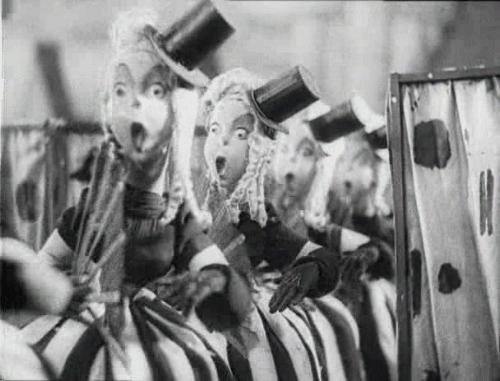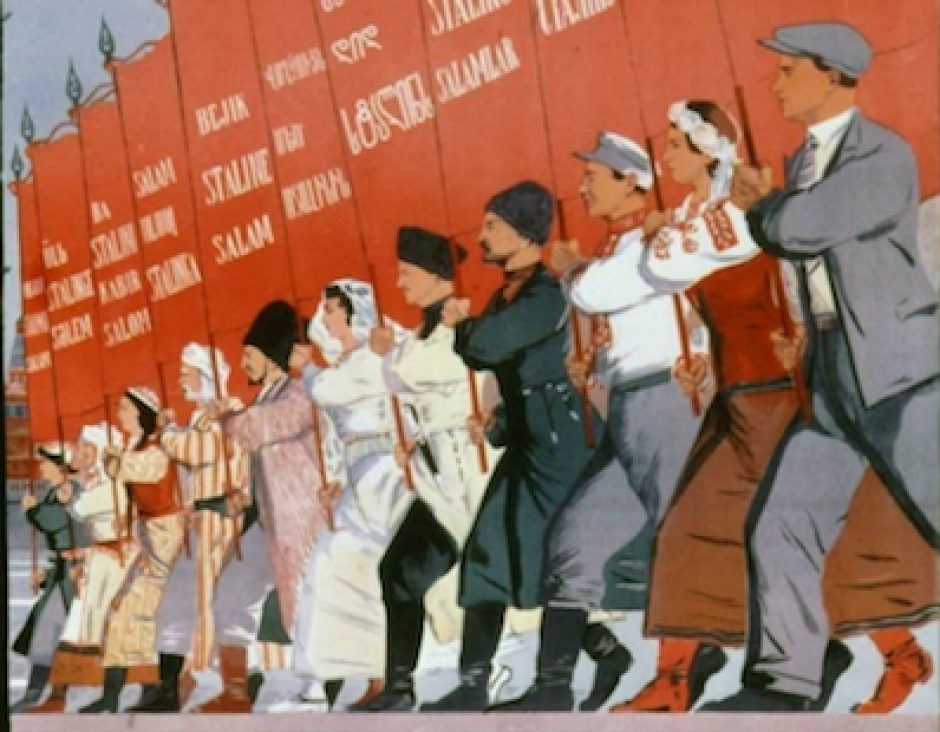A Brief History Ending with the “Golden Age” of Soviet Animation
Russian animation began in the Tsarist empire with Wladyslaw Starewicz’s innovative technique of stop motion embalmed insects. Though it is now discovered another animator existed before him, Starewicz’s productions were the first publicly released and they gained international acclaim (“History of Russian Animation” n.d.). He would produce folk-tale and WWI propaganda films until fleeing the 1917 revolution, at which point animation in the region came to a halt for several years (Rollberg 2016).

Starewicz’s The Beautiful Lukanida
In the 1920s to early 30s, Soviet animation took on many diverse styles, techniques and genres. Often inspired by avant-garde aesthetics, Soviet animators wished to invent a uniquely Soviet form of animation. Drawn animation as well as puppet, and paper cutout techniques portrayed political propaganda, children’s stories (sometimes, but not always propagandistic), histories and literature adaptations. Interestingly it was unacceptable to produce animated films based on folk talks until 1934 (Rollberg 2016). Folk tales were considered backwards products of undeveloped peasant culture (Kononenko 2011). How and why this changed will be discussed below.

Dziga Vertov’s Soviet Toys (1924) A political cartoon

Aleksandr Ptushko’s The New Gulliver (1935) Source: http://russian-and-soviet-cinema.tumblr.com/post/112623145214/novyi-gulliver
By 1935, the many animation studios such as VGIK, Mexhrabpomfilm, Mosfilm, Lenfilm, and VUFKU had been consolidated into Soyuztmultfilm. Impressed by Walt Disney’s ‘naturalistic’ drawn animation, Soyztmultfilm abandoned and prohibited styles and techniques not naturalistic, including stop motion, and turned to the efficient and quantitatively successful US technologies. This style of socialist realism would continue through the 40s and 50s. The war period would not produce many films, as Soyuztmultfilm was evacuated and relocated, causing great logistical issues. Post-war films often took inspiration from folk and fairy tales (Rollberg 2016).

Lev Atamanov’s The Golden Antelope (1954) Source: https://imgur.com/gallery/kQM3n
After Roman Kachanov’s A Cloud in Love (1959) once again displayed avant-garde aesthetics and combined cutout, drawn and puppet animation, especially due to the changed political climate of Khrushchev’s thaw, diverse aesthetics and techniques once again replaced the homogenized ‘realism’ of years past (“History of Russian Animation” n.d.).
Yuri Norstein Hedgehog in the Fog (1975) Internationally acclaimed as the best animated movie of all time.
Folk Tales and Social Mores
Folk tales, once considered backwards and antithetical to the modern proletariat state, became a central subject for animated films, along with international and Russian literary classics, such as Winnie-the-Pooh and The Jungle Book. This change began with the writer Maxim Gorky’s speech in 1934 proposing folk tales’ ability to provide models for Soviet laborers to emulate. Animated folk tales became important in their ability to demonstrate national heritage and moral values, presented in an entirely modern medium. Compared with the United States’ Disney portrayal of traditional tales, Soviet animators changed the original stories very little in their adaptations. The most noticeable difference lay in the removal of violence from stories especially to emphasize the valued character trait of Soviet good-neighborliness. Folk tales, and international literary classics were also distinct in their lack of state censorship. Unlike original stories, folk tales were thought apolitical and un-ideological because they preceded the development economic and political structures and class-consciousness. They held moral and ethical lessons in the place of political ones (Kononenko 2011).
Portrayals of gender defined the second main manner in which folk tales were changed when adapted to the screen. For example, Nu, Pogodi, a television series replaces a traditional archetypal trickster hero, Sister Fox, with a male wolf and an effeminate male rabbit, voiced by a woman. The well-behaved, dutiful rabbit often deceives the wolf, who is brutish and guided by desirous, impulsive, and destructive feelings. In this instance, there are not female characters, but in shows with women, these chararcters are obedient, silent, hard-working, subservient, and sexless (Kononenko 2011). Nu, Pogodi, like Vinnipukh, features effeminate male secondary characters (in Vinnipukh, Piglet, Rabbit, and female-voiced Owl) contrasted with self-indulgent, and forceful protagonists (Fishzon 2015).

National Portrayals
Folk tales, though important in their ability to portray soviet moral ideals, continued to be associated with peasantry and backwardness. For that reason, non-Russian nationalities in the USSR were associated with folk tales as well as folksy ways Animation studios in other soviet republics adhered to superficial and stereotypical portrayals of peripheral nationalities just as much as Soyuzmultfilm. Not only that, non-Russian animated television shows and movies did not use dialogue or language to move the plot along, rather music, action, and pictographs for thought bubbles, for example, ensured that anyone in the USSR could watch and follow the show. Russian animated films made no such attempt at universality, or more accurately, the Russian language was understood as universal throughout the empire, and citizens of any nationality were expected to know and understand it (Kononenko 2011). To demonstrate more specifically national consideration’s effects on animated film, we’ll consider a film and a series below.
In soviet culture, folklore dances served to demonstrate the diversity of the soviet union and the brotherhood of nationalities cooperating to build a socialist world. Each nationality would take turns with a few dance steps, showing off national traditional dress, before Russia finishes the dance as the central unifying actor. These dances are alluded to in the plot structures of many animated films, such as Terem Teremok (1971). Terem Teremok is based on a folk tale in which more and more different animals wish to live in a small hut, resulting in the huts destruction when a bear proves too big. The film changes the original story so that after destroying the hut, the bear leads the other animals to build a bigger, better, modern house. As Natalie Kononenko puts it, “While the various nations (animals) may feel the Russian bear’s huge and oppressive presence, sitting atop their nations (homes), they need to give him a chance. His size and might will allow him to lead the other members of the Soviet family in building a much bigger and better Union.” This is not the only edit with an ideological purpose. When each new animal wishes to move into the hut, they are welcomed and received but first asked what work they can do to add to the hut, demonstrating the character traits of hard work and dutifulness as well as welcoming good-neighborliness (Kononenko 2011).
Another manner in which pervasive national thoughts affected and were perpetuated by animated films can be demonstrated through the example of the Ukrainian Kievnauchfilm’s Kozak series. Because Russian understandings of Ukraine historically considered it the rural peasant countryside of Russia (with a folksy accent of Russian rather than its own language), Ukrainian characters were stereotyped and patronized as backwards. Though the main characters of the Kozak series are based on the heroic, idealized, virile and masculine Ukrainian folk heroes, the kozaks running about the television screen are slapstick, out-of-touch, rubes who do such things as use the World Cup trophy as a cooking pot, or rescue their wives from pirates with their colorful traditional music. Spirits may show up in both Russian and Ukrainian animated films, but because of their cultural development, Russian characters do not fear them. The kozaks, on the other hand, are terrified by spirits, who end up being results of intoxication more than supernatural apparitions. Along with such backwards mentalities, Ukrainians can clearly be identified in animated films by their traditional rural dress, singing and dance, food, and other such soviet approved markers of their nationality (Kononenko 2011).
https://youtu.be/mNiDgDUL3So?t=10m3s
https://youtu.be/Bd-lt6-AceY?t=14m52s
Works Cited
Fishzon, Anna. 2015. “THE FOG OF STAGNATION: Explorations of Time and Affect in Late Soviet Animation.” Cahiers Du Monde Russe 56 (2/3): 571–98.
“History of Russian Animation.” n.d. Accessed February 28, 2018. http://russia-ic.com/culture_art/theatre/1529#.WpcVvJPwbdS.
Kononenko, Natalie. 2011. “The Politics of Innocence: Soviet and Post-Soviet Animation on Folklore Topics.” The Journal of American Folklore 124 (494): 272–94. https://doi.org/10.5406/jamerfolk.124.494.0272.
Rollberg, Peter. 2016. Historical Dictionary of Russian and Soviet Cinema. Rowman & Littlefield.
